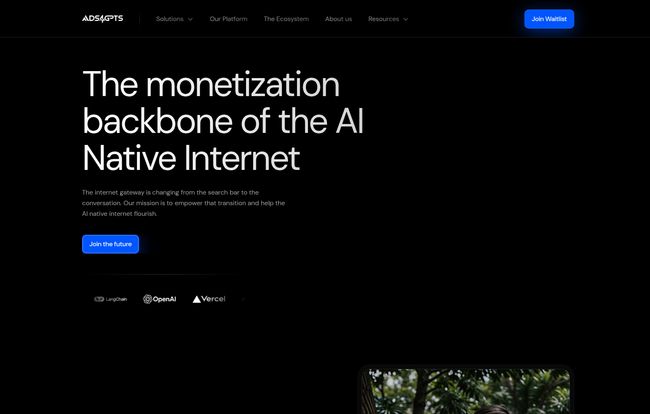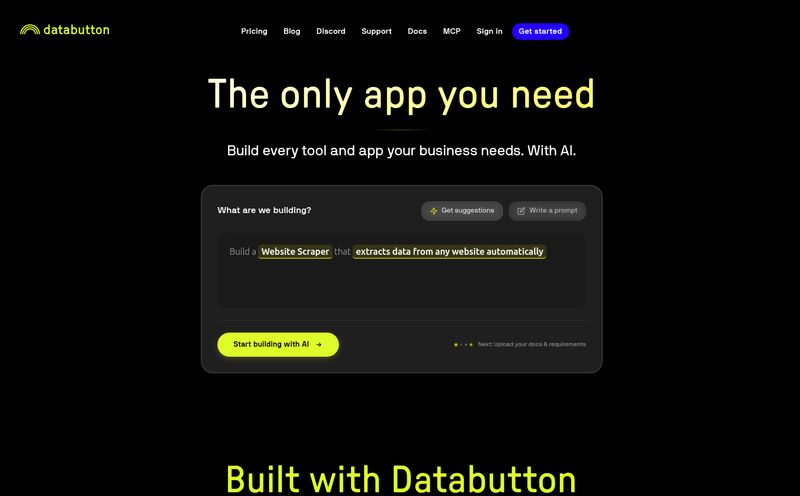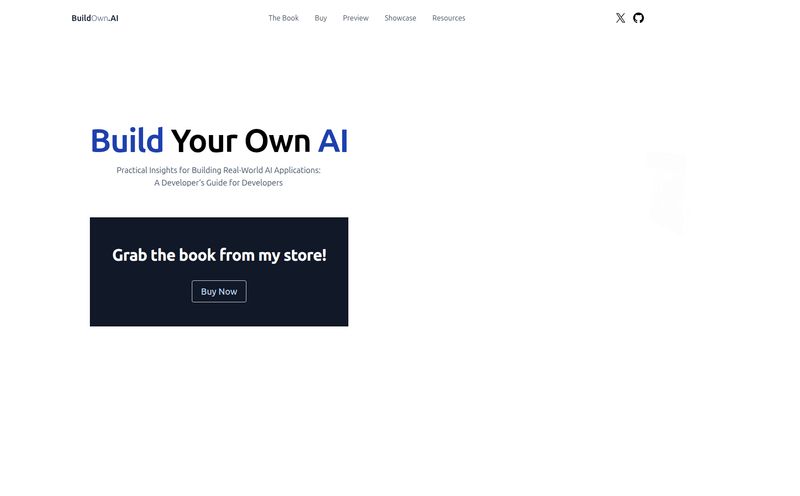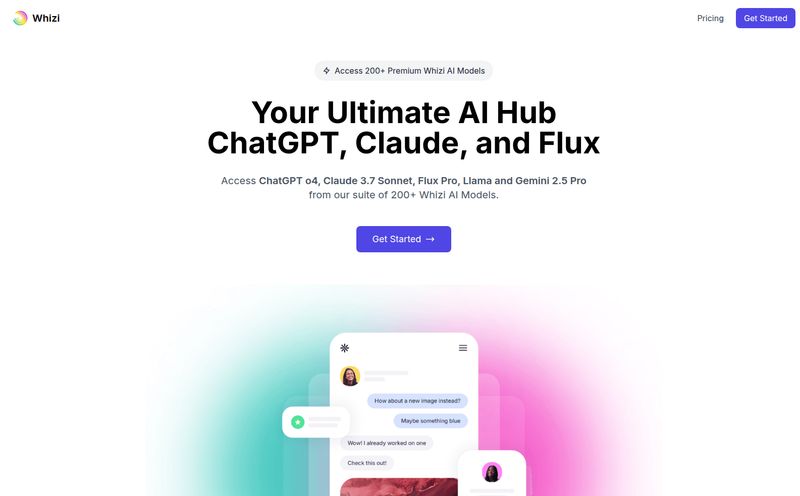The AI gold rush is in full swing. Everyone and their dog is building a custom GPT or a slick little LLM app. It's exciting, it's chaotic, and it feels like the early 2000s internet all over again. But there's a giant, nagging question hanging in the air for most of these creators:
How the heck do I make money from this?
Subscriptions are one way, sure. But not every tool warrants a monthly fee. And pay-per-use can feel… transactional. For years, the backbone of the open internet has been advertising. For better or worse, it’s what keeps the lights on for millions of creators. But you can't just slap a clunky banner ad in the middle of a chatbot conversation. It would be jarring, weird, and completely kill the vibe.
So, the puzzle has been: how do you monetize these new conversational interfaces without ruining them? I've been watching this space closely, and a new player called ADS4GPTs just popped onto my radar, claiming to be the "monetization backbone of the AI Native Internet." A bold claim. Let’s see if it holds up.
So, What Exactly is ADS4GPTs?
In the simplest terms, ADS4GPTs is an ad network built specifically for AI environments. Think of it less like the loud, obnoxious banner ads of yesterday and more like a smart, subtle product placement in a movie. It's designed to integrate programmatically into AI Agents, custom GPTs, and other LLM-powered applications.

Visit ADS4GPTs
The core idea isn't to interrupt the user, but to complement the conversation. Imagine you're using a travel-planning GPT to map out a trip to Kyoto. You're discussing the best time to see the cherry blossoms and which temples to visit. Right within the chat, the AI might present a highly relevant offer: "By the way, here's a deal on a hotel near the Fushimi Inari shrine for your dates."
It’s advertising, yes, but it’s contextual. It feels less like an ad and more like a helpful suggestion. And that, right there, is the holy grail.
The Great Monetization Challenge for AI Developers
I’ve spoken with so many indie developers who have built incredible AI tools but are struggling with the business model. They've poured hundreds of hours into creating something genuinely useful, only to hit a wall when it comes to generating revenue. It's a classic problem that platforms like YouTube and the App Store eventually solved for their creators.
AI needs its own version of this. It needs a native solution that understands the medium. ADS4GPTs is one of the first serious attempts I’ve seen to build that infrastructure. They seem to understand that the old model is broken in this new context.
How This Platform Aims to Fix the Problem
From what I've gathered on their site, their approach is built on a few key pillars. It's not just about showing ads; it's about how they're shown, why they're shown, and who they're shown to.
Context is Everything
This is the big one. The platform’s effectiveness hinges on its ability to understand the conversation's context. The ads are triggered by the topic at hand, not by a profile built on your browsing history from the last six months. This makes the ads genuinely useful. It moves them from being an annoyance to being a feature. The platform mentions an "AI Notice Integration," which sounds like a transparent way of telling the user, "Hey, this conversation may include relevant offers," which I think is a smart, ethical move.
A Surprising Focus on Privacy
Here’s what really caught my eye. ADS4GPTs boasts a privacy-first design with zero PII (Personally Identifiable Information) collection. In a world reeling from the death of the third-party cookie and growing skepticism around data tracking, this is a massive selling point. Advertisers don’t get your name or your email; they just get to place their message in front of someone who is actively discussing a need for their product. It's a return to the old-school, privacy-respecting advertising model of magazines and television, but with the precision of digital.
Open Standards and (Hopefully) Smooth Integration
They’re promoting open-source integrations and have names like OpenAI and Vercel on their site, which lends them a lot of credibility. They promise a "seamless and developer-friendly integration." Now, I've been in this industry long enough to be a little cynical about the word "seamless." One of the potential downsides is that this will likely require some technical chops to implement. It’s not going to be a simple WordPress plugin. But for the developers already building complex AI apps, this might not be a major hurdle. The promise of "AI Native Ad Specs" also suggests they're thinking about creating new, interoperable ad formats that feel natural inside a chat interface, which is very forward-thinking.
A Tale of Two Users: Who Benefits?
A network like this only works if it provides real value to both sides of the marketplace: the people with the AI apps and the people with the ad budgets.
For the AI creator, the benefit is obvious: a new revenue stream. It’s a way to get paid for your work without forcing every user into a subscription. It could democratize AI development, allowing more people to build and sustain niche, helpful tools.
For the advertiser, the proposition is equally compelling. You get access to a high-intent audience at the exact moment they are expressing a need. There's no guesswork. You're not just hoping someone is interested in travel; you know they are. The promise of guaranteed viewability and brand safety controls is also a huge plus for brands wary of the wild west of programmatic ad exchanges.
The Big Questions: What About Pricing and Performance?
Okay, let’s talk about the elephant in the room. Right now, there is no public information on pricing or revenue share models. The platform is currently operating on a waitlist basis, which is common for new tech rolling out carefully. We don't know what the CPMs or CPCs will look like. We also have limited information on the specific ad formats and how performance will be measured.
This is the great unknown. The entire model's success will depend on whether it can deliver a strong ROI for advertisers and a meaningful income for developers. It's a chicken-and-egg problem, but a necessary one to solve.
My Take: Is This the Future or Just Another Fad?
So, what’s my final verdict? Cautiously optimistic. Very optimistic, actually.
I've been in the SEO and traffic generation world for over a decade, and I've seen countless platforms come and go. Most fail because they don't solve a real problem or because their tech isn't up to snuff. ADS4GPTs, at least conceptually, solves a massive, growing problem. The internet is shifting from a web of pages to a web of agents and conversations, and the economic model has to shift with it.
This feels less like a fad and more like a necessary evolution. It reminds me of the moment Google AdSense appeared and suddenly gave small bloggers and forum owners a viable way to make a living. This could be that moment for the explosion of AI creators.
Of course, execution is everything. If the contextual matching is poor or the ads are low-quality, it will fail spectacularly. But if they get it right… this could be the start of a whole new ecosystem.
A New Beginning for AI Monetization?
The rise of conversational AI presents both a challenge and a huge opportunity. The old ad models are dead in this new world. Platforms like ADS4GPTs are stepping in to write the new rules. By focusing on context over personal data and aiming for a user experience that is helpful rather than intrusive, they might just have cracked the code.
It’s early days, for sure. But I've joined the waitlist, and I’m genuinely excited to see how this unfolds. This isn't just another ad network; it’s a potential blueprint for a more sustainable, privacy-focused, and creator-friendly AI-native internet. And that's something I can get behind.
Frequently Asked Questions
- What is ADS4GPTs?
- ADS4GPTs is an AI-native ad network designed to help developers monetize their AI applications, like custom GPTs and LLM apps. It places contextually relevant, non-intrusive ads directly within AI conversations.
- How does ADS4GPTs handle user privacy?
- The platform is built on a privacy-first model. It does not collect any Personally Identifiable Information (PII) from users. Ads are targeted based on the real-time context of the conversation, not on a user's personal data or browsing history.
- Can I use this for my small custom GPT project?
- Yes, that's the goal. The platform is intended for AI application developers of all sizes, from individual creators to larger companies, who want to generate revenue from their creations.
- What does it cost to use ADS4GPTs?
- Currently, information about pricing and revenue sharing models is not public. The platform is in a waitlist phase, and details will likely be available to those who are accepted into the program.
- Who can advertise on the platform?
- Advertisers who want to reach high-intent users within AI environments can use the platform. It's ideal for brands whose products or services can be matched to conversational contexts, such as travel, e-commerce, software, and more.
- Is it difficult to integrate ADS4GPTs into an app?
- While the platform aims for a "developer-friendly integration," it will likely require some technical knowledge. It's designed for developers building on platforms like OpenAI and Vercel, so a baseline understanding of APIs and app development is probably necessary.
Reference and Sources
- ADS4GPTs Official Website
- Wired: The Shift from Search to Conversational AI
- Google's Blog on The End of Third-Party Cookies



